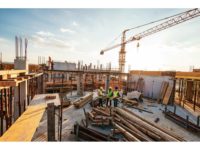Q&A: The Air Barrier Association of America

At Building Enclosure, we enjoy spotlighting organizations that are bettering the industry we serve. This issue, we wanted to dedicate some time to the Air Barrier Association of America (ABAA) and all the work they’re currently doing to better our markets.
“ABAA is the national voice of the air barrier industry and has raised the level of quality in the industry through a Quality Assurance Program (QAP) and offers premier training, certification, product evaluations, contractor accreditation and site quality control audits,” says Robert Aird, President and Vice Chair of ABAA. “We are active in the areas of research, education, standards development, building codes and technical resources for the air barrier industry.”
There are many challenges in the construction industry. ABAA’s specific focus is on water-resistive air barriers. The current emphasis on conserving energy in buildings is important for reducing energy expenditures and for occupant comfort. Durability and low-maintenance costs are part and parcel to that effort. ABAA’s mission is “to work together with our membership, industry and trade to be the recognized voice for air barriers.”
The association is developing documents specifically for the air- and water-resistive barrier industry, from test methods to material specifications to three-part project specifications. They call it “ABAA version 3.” A variety of important research is being conducted so that all work and standards can be validated and proven scientifically defensible.
The air- and water-resistive barrier industry is relatively new and therefore needs to set the standards by developing documentation, publications, best practice guides that other industries have developed over the years. This includes material test methods, material specifications that outline performance requirements, air barrier assembly test methods and a wide range of other items to support the design, installation, materials and inspections.
All of the needed best practices for the industry have to be developed from scratch. The other major challenge is that there is still a large segment of people do not know, or fully understand the function of air- and water-resistive barriers, why they are needed and how then perform within the building envelope. A tremendous amount of education is needed at every level.
Which is where ABAA comes in. To achieve this, some of their goals are:
- Architectural training and education to specify and uphold the QAP through construction.
- Collaborate on educational and sales efforts with members.
- Increase educational efforts to the architectural community.
- Increased involvement with regional BEC, CSI, AIA, IIBEC and other organizations chapters.
- Work directly with specific architects.
“A segment of the industry is realizing that the building envelope is critical for the overall performance of the building from an energy standpoint and moisture management standpoint,” says Laverne Dalgleish, Executive Director of the ABAA. “The industry is starting to realize that for the building envelope to perform, we need to understand how it performs, how things integrate, how things are installed and designed and where we can make improvements. We have seen an increased uptake in applying building science to designing the building envelope and we are starting to tackle items like how long is the buildings useful life and how do we determine durability and resilience.”
Architects and other designers recognize that it is possible to design and build structures that are more energy-efficient and less expensive to maintain. Poor design and construction cost the country billions of dollars. Education and quality control efforts are beginning to turn the tide to that recognition.
ABAA provides training nationwide to organizations and individuals who want to improve their knowledge of the science and means and methods of designing and constructing buildings. And a good portion of those people are young and see a future in the industry.
“We’re doing everything we can to draw in the younger generation, but that is still a tall task,” Dalgleish says. “The industry needs a wide swath of talents from architects and engineers to site workers and everybody in between. The construction industry is not seen as THE place to go. The biggest initiative is to provide education to the younger generation and help them understand a career path in the industry.”
Technical work within the industry is breaking new ground in many areas, and it’s exciting to see new standards and reference documents developing that will direct future design and building construction. There is positive excitement attached to the trend for the construction industry to take pause and recognize the ultimate benefits of designing and constructing buildings that are energy efficient, safe and durable.
Looking for a reprint of this article?
From high-res PDFs to custom plaques, order your copy today!






